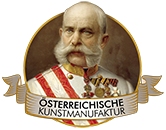The illustrator, sculptor and painter Eugene Grasset was born in 1845 in the French-speaking Swiss city of Lausanne. From his father, who was a master carpenter, he learned the practical methods of working with wood and many other materials. Eugene Grasset acquired his sense of lines, shapes, proportions and drawing precision while studying architecture at the ETH Zurich. After graduating, his family took him on an extended trip to Egypt in the late 1860s. During this excursion, Eugene Grasset found not only his adolescence, but also his life's mission. On the one hand, the foreign culture awakened his interest in Egyptian art. On the other hand, through the broadening of horizons and inspiring encounters, he found in himself a strong enthusiasm for Japanese prints.
Back in Switzerland, he started his professional career designing posters. Soon he became active in almost all levels of artistic creation. In 1871 he settled in Paris, where he designed pieces of furniture, painted pictures and formed sculptures from gemstones. It was his works made of colored glass that made him successful. The buyers were churches, coffee houses and rich families. Eugene Grasset is considered a representative of the Belle Époque and a pioneer of Art Nouveau. At the Académie de la Grande Chaumière in Paris, he taught numerous later famous artists from 1905 until his death in 1917. One of his most famous works is "The Wooly Horse." The painting was commissioned by a magazine for a series on the life of Napoleon. It combines painting and illustration technique and became so famous that Louis Comfort Tiffany reproduced it from colored glass.
×





 - (MeisterDrucke-51729).jpg)
 - (MeisterDrucke-51729).jpg)
 - (MeisterDrucke-154776).jpg)
 - (MeisterDrucke-154776).jpg)
.jpg)
.jpg)
.jpg)
.jpg)
.jpg)
.jpg)
.jpg)
.jpg)
.jpg)
.jpg)
.jpg)
.jpg)
_-_(MeisterDrucke-950460).jpg)
_-_(MeisterDrucke-950460).jpg)
.jpg)
.jpg)
.jpg)
.jpg)
.jpg)
.jpg)
.jpg)
.jpg)
.jpg)
.jpg)
 - (MeisterDrucke-188633).jpg)
 - (MeisterDrucke-188633).jpg)
.jpg)
.jpg)
.jpg)
.jpg)
.jpg)
.jpg)
.jpg)
.jpg)
.jpg)
.jpg)
.jpg)
.jpg)
.jpg)
.jpg)
.jpg)
.jpg)
.jpg)
.jpg)
.jpg)
.jpg)
.jpg)
.jpg)
.jpg)
.jpg)
.jpg)
.jpg)
.jpg)
.jpg)
.jpg)
.jpg)
.jpg)
.jpg)
.jpg)
.jpg)
.jpg)
.jpg)
.jpg)
.jpg)
.jpg)
.jpg)
.jpg)
.jpg)
.jpg)
.jpg)
.jpg)
.jpg)
.jpg)
.jpg)
.jpg)
.jpg)
 at the Renaissance Theatre (see 127035) - (MeisterDrucke-184298).jpg)
 at the Renaissance Theatre (see 127035) - (MeisterDrucke-184298).jpg)
.jpg)
.jpg)
.jpg)
.jpg)
.jpg)
.jpg)
.jpg)
.jpg)
.jpg)
.jpg)
.jpg)
.jpg)
.jpg)
.jpg)
.jpg)
.jpg)
.jpg)
.jpg)
 receiving the submission of the Saxons in 785 - (MeisterDrucke-176395).jpg)
 receiving the submission of the Saxons in 785 - (MeisterDrucke-176395).jpg)
.jpg)
.jpg)
_1894_Lithography_by_Eugene_Samuel_-_(MeisterDrucke-917716).jpg)
_1894_Lithography_by_Eugene_Samuel_-_(MeisterDrucke-917716).jpg)
.jpg)
.jpg)
.jpg)
.jpg)
.jpg)
.jpg)
_-_(MeisterDrucke-1381707).jpg)
_-_(MeisterDrucke-1381707).jpg)
.jpg)
.jpg)
.jpg)
.jpg)
.jpg)
.jpg)
.jpg)
.jpg)
.jpg)
.jpg)
.jpg)
.jpg)
.jpg)
.jpg)
.jpg)
.jpg)
.jpg)
.jpg)
_holding_a_banner_decorore_of_a_boar_teaches_-_in_-_(MeisterDrucke-952403).jpg)
_holding_a_banner_decorore_of_a_boar_teaches_-_in_-_(MeisterDrucke-952403).jpg)
.jpg)
.jpg)
.jpg)
.jpg)
.jpg)
.jpg)
.jpg)
.jpg)
.jpg)
.jpg)
.jpg)
.jpg)
.jpg)
.jpg)
.jpg)
.jpg)
.jpg)
.jpg)
.jpg)
.jpg)
.jpg)
.jpg)
.jpg)
.jpg)
.jpg)
.jpg)
.jpg)
.jpg)
.jpg)
.jpg)
.jpg)
.jpg)
.jpg)
.jpg)
.jpg)
.jpg)
.jpg)
.jpg)
.jpg)
.jpg)
.jpg)
.jpg)
.jpg)
.jpg)
.jpg)
.jpg)
.jpg)
.jpg)
.jpg)
.jpg)
.jpg)
.jpg)
.jpg)
.jpg)
.jpg)
.jpg)
_-_(MeisterDrucke-1645173).jpg)
_-_(MeisterDrucke-1645173).jpg)
.jpg)
.jpg)
.jpg)
.jpg)
.jpg)
.jpg)
_pl_-_(MeisterDrucke-1000985).jpg)
_pl_-_(MeisterDrucke-1000985).jpg)






